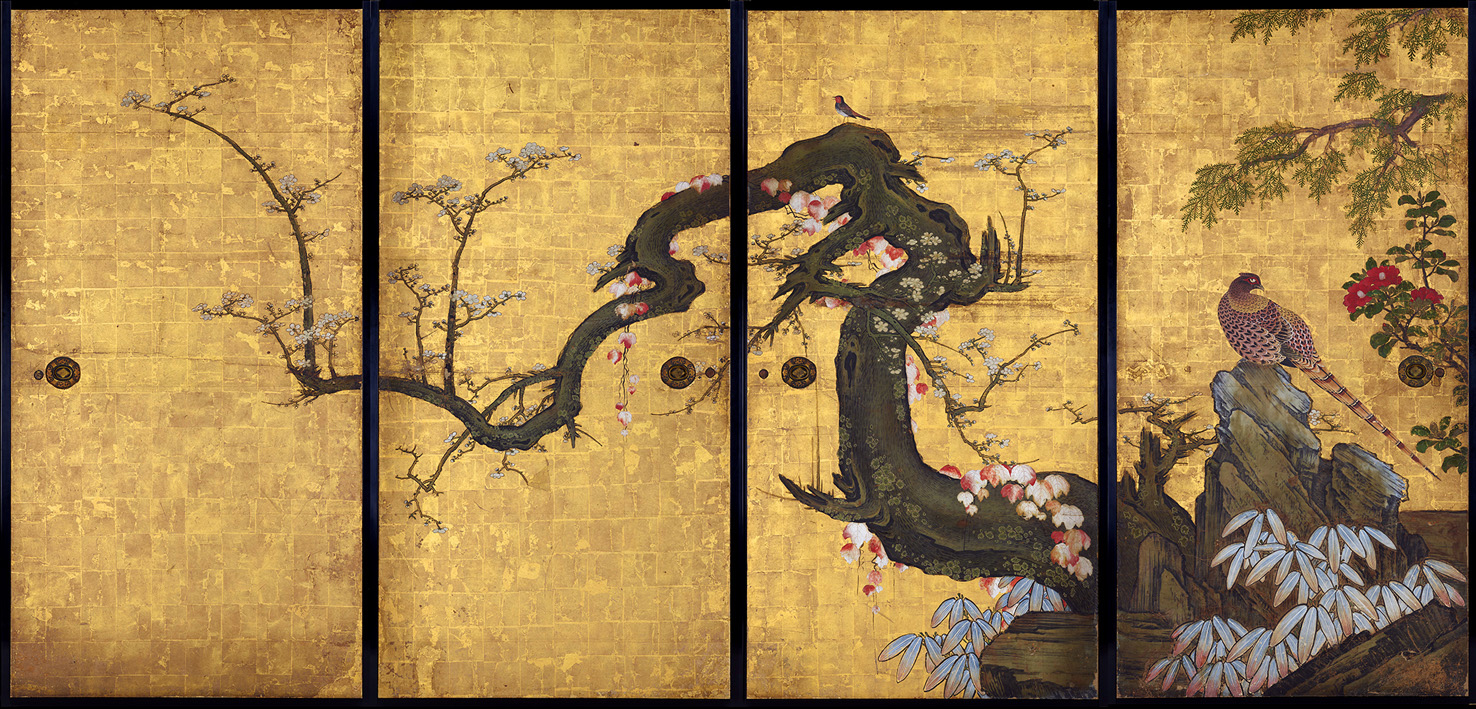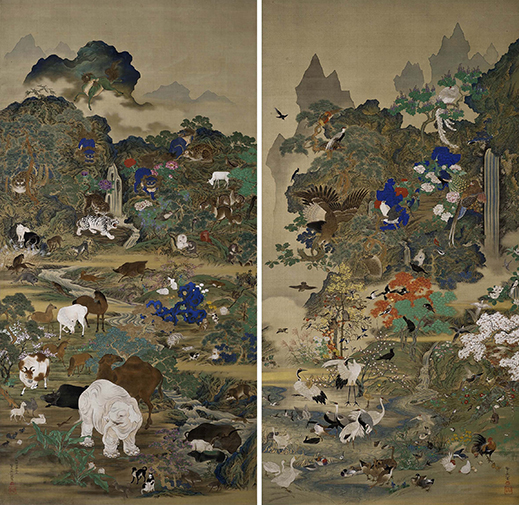 |
Focus features two in-depth reviews each month of fine art, architecture and design exhibitions and events at art museums, galleries and alternative spaces around Japan. The contributors are non-Japanese residents of Japan. |
|
|
 |
 |
 |
Breaking the Mold: Unique Images from the Days of Edo
J.M. Hammond |
 |
|
Ito Jakuchu, Rooster and Gardenia, hanging scroll, color on silk
|
|
Hakuin Ekaku, Bodhidharma (Daruma), hanging scroll, color on paper, Manjuji temple, Oita prefecture |
Mavericks, by definition, don't easily fit into categories, even if mainstream Japanese art history is written around schools and styles. During the Edo period (1603-1867), in particular, a number of artists known for their eccentric personal styles made a name for themselves, but in subsequent eras were overlooked -- until fairly recently.
Over the past few decades many of these artists have received renewed and dedicated attention, one major impetus being a 1970 book by art historian Nobuo Tsuji titled Lineage of Eccentrics. The author shined a light on six remarkable artists who had not as yet been included in art exhibitions in Japan: Soga Shohaku, Nagasawa Rosetsu, Utagawa Kuniyoshi, Kano Sansetsu, Iwasa Matabei, and Ito Jakuchu.
Since that time, the Kyoto-born Jakuchu (1716-1800) in particular has become wildly popular. When a Jakuchu exhibition was held at the Tokyo Metropolitan Art Museum in 2016, crowds lined up for hours in the surrounding Ueno Park just to get a glimpse of his works. Now, the same museum is continuing its exploration of distinctive Edo-period art with Lineage of Eccentrics: The Miraculous World of Edo Painting, a new show that brings together the six artists who appeared in Tsuji's book along with two more oddballs, Hakuin Ekaku and Suzuki Kiitsu.
The aim is to both satisfy the hunger of those who have already developed a taste for these artists, and whet the appetite of audiences not yet familiar with them. One hope is to encourage viewers to make some connections between what they see here and aspects of contemporary Japanese art, at a time when big names like Takashi Murakami have expressed deep interest in these eccentric artists and have used their works as inspiration.
 |
|
Ito Jakuchu, Elephant and Whale, pair of six-panel screens, ink on paper, 1797, Miho Museum, Shiga prefecture |
The exhibition opens with Jakuchu's impressive pair of screens Elephant and Whale, which he painted toward the end of his life. The king of the sea, in black, is depicted as it cuts through the waves and sinks back under the water. The largest of all land animals, in white, sits heavily on the shore. A few more of Jakuchu's monochrome ink works on paper are on display, alongside the kind of colorful, detailed paintings that have made him so popular in recent years, such as the glorious Phoenix and Sun.
Tsuji's book has been pivotal in the reevaluation of the careers of these artists, but art collectors have been equally crucial. The American art connoisseur Joe Price fell in love with Jakuchu's work when the artist was still largely unknown. Price and his wife have been generous in lending items from their Jakuchu inventory to various exhibitions in Japan, including this one, where their Mandarin Ducks amid Snow-covered Reeds is on display. It demonstrates just how playful Jakuchu can be, as in his depiction of one duck half submerged under the water's surface.
Jakuchu mainly painted animals and flowers -- not exactly considered avant-garde subject matter today -- so it may not be obvious why he is described as an eccentric painter. In his day, however, most artists made a living producing what was required by their patrons -- temples, shoguns and other powerful entities -- and in many cases painted not from life but from established precedents. Jakuchu is said to have had the luxury of living on an inheritance, and could paint any subject in any way he desired. He chose to depict things from the natural world, and is said to have kept chickens outside his home so he could draw them when the whim struck. Working from direct observation (with a dash of poetic license) in this way was, in itself, quite radical.
The growing interest in Jakuchu in contemporary Japan, while welcome, is not always for the most edifying of reasons -- not only are his works pretty, but many are vertical in format, making them perfect for dressing up a smartphone. Among other reasons, apparently, the fact that the artist's name chimes with that of Pikachu from the Pokémon franchise guarantees he's off the scale on many young women's kawaii (cute) meter. Still, anything that gets people interested in his art is a move in the right direction.
The one work that perhaps most clearly shows how Jakuchu defied convention is Jokyoshu (Impromptu Pleasures Afloat), a long hand-scroll painting, in ink on paper, in the possession of the Kyoto National Museum. It depicts the environs along the Yodo River in Osaka. In the manner of a photographic negative, the landscape is unnaturally lighter than the pitch-black sky, and buildings and people are outlined in white, their shapes filled in with black or gray. It is almost as if the artist presaged the photographic revolution.
 |
|
Soga Shohaku, Sessen Doji Offering His Life to an Ogre, hanging scroll, color on paper, c. 1764, Keishoji temple, Mie prefecture |
Though Jakuchu may be the most popular of these eccentrics, it was in fact a work by another Kyoto-based artist, Soga Shohaku, that inspired Tsuji to write his book nearly fifty years ago. Some people consider Shohaku's best-known paintings of Chinese sages and immortals to be rather wild and almost psychedelic in their frenzied detail, and in that respect a bit too chaotic, but there is nothing too alarming in this exhibition. Moreover, Shohaku worked in a range of styles, and his Mount Fuji and Miho no Matsubara displays an altogether softer touch. The exhibit includes his wonderful hanging scroll The Three Laughers of Tiger Ravine, showing three men on a bridge in the mountains. Like a number of works in the exhibition, today it seems to have a pronounced modern look. The cartoon-like clouds, white and puffy, contrast with sharply hewn rock done in dynamic brushwork that would not be out of place in a manga strip.
Turn a corner and you are confronted with Nagasawa Rosetsu's White Elephant and Black Bull. In its strong color contrasts, it has similarities with Elephant and Whale by his contemporary Jakuchu, but Rosetsu adds a further contrast -- that between large and small. The huge forms of the two animals cannot be completely contained within the borders of the frame, and the artist further accentuates their bulk by placing two black crows on the back of the white elephant and a tiny white puppy at the foot of the black bull, thus combining juxtapositions of both color and size. The soft fluffiness of the dog is reminiscent of puppies painted by Maruyama Okyo, who is one of the key originators of kawaii images in Japanese art. Rosetsu studied under Okyo at his Kyoto workshop and moved on to hone his own style after soaking up everything he could under the master.
 |
|
Nagasawa Rosetsu, White Elephant and Black Bull, pair of six-panel screens, ink on paper, Etsuko and Joe Price Collection, USA |
There is a lot to get through in this exhibition, but never a dull moment -- even if it is not always quite clear (at least to those relying on English captions) what exactly is considered "eccentric" about some of the images. Kano Sansetsu is a case in point. Unlike many of the artists in the show who really did chart their own course, Kano was, to some extent, an heir to a tradition. Marrying the daughter of his master Kano Sanraku, he was to become the successor of one branch of the long-running Kano school, painters to the Shoguns and various Buddhist temples. (When Kano Tan'yu, the head of the main branch of the Kano school, relocated to Edo with the establishment of the Tokugawa Shogunate's new capital there, Sanraku and Sansetsu stayed in Kyoto, shaping what was to become known as the Kyo-Kano school.)
Some of Sansetsu's works do not seem too far out of line with the basic style he inherited (one of the main tenets of which was to copy closely from the masters rather than draw from life), but the exhibition points to examples of his originality -- the stylization of the twisted, gnarled branches of a tree, for example. The acute observation of gesture and pose suggested by his study of samurai performing Sumo is indeed closer to the work found in Katsushika Hokusai's manga output than anything you would expect from the Kano school. Most surprisingly, perhaps, Sansetsu turns his attention to the common man in his Agricultural Scene in the Four Seasons.
 |
|
Kano Sansetsu, Plum Blossoms and Frolicking Birds, four sliding panels, color, ink, and gold foil on paper, 1631, Tenkyuin temple, Kyoto (Important Cultural Property) |
While the show highlights the innovative steps taken by these artists, when their works are viewed in the context of their whole career, it is clear that even the most out-there among them have built on the achievements of their forebears: even these eccentrics are standing, as it were, on the shoulders of giants.
Of the two artists added to Tsuji's original six, the inclusion of Suzuki Kiitsu reflects the reappraisal this stylish artist has been enjoying in recent years. Not only have researchers increasingly turned their attention to his work, but a large exhibition at the Suntory Museum of Art in 2016 was dedicated to Kiitsu's career.
Like Kano Sansetsu, Kiitsu built on a tradition, in this case the Rimpa school, or more precisely Edo Rimpa. He studied under Sakai Hoitsu, who revived, in Edo, the Rimpa style of Ogata Korin and related Kyoto artists. Kiitsu learned from the best -- which, as the detail of One Hundred Birds, One Hundred Animals suggests, includes Jakuchu -- and in time was not shy about taking it further. His pair of screens Mountain Stream in Summer and Autumn is unabashedly stylized. The rich azure he uses is not the most natural color for a river, and the bright white outlines around the leaves on the right panel enhance the work's almost pop quality.
There is more going on in Lineage of Eccentrics than can possibly be detailed here -- such as a number of Utagawa Kuniyoshi's whimsical and macabre woodblock prints -- so unleash your inner rebel and check out these mavericks for yourself.
Note: The exhibition is divided into two periods, 9 February to 10 March and 12 March to 7 April, with some changes to the exhibits.
 |
|
Suzuki Kiitsu, One Hundred Birds, One Hundred Animals, pair of hanging scrolls, ink, color and gold pigment on silk, 1843, The Catherine and Thomas Edson Collection, USA |
All images courtesy of the Tokyo Metropolitan Art Museum. |
 |
 |
J.M. Hammond
J.M. Hammond researches modernity in Japanese art, photography and cinema, and teaches in Tokyo, including as a faculty lecturer in the English department at Meiji Gakuin University and at Gakushuin University. He has written about art for The Japan Times for over a decade. His essays include "A Sensitivity to Things: Mono No Aware in Late Spring and Equinox Flower" in Ozu International: Essays on the Global Influences of a Japanese Auteur (Bloomsbury, 2015) and "The Collapse of Memory: Tracing Reflexivity in the Work of Daido Moriyama" for The Reflexive Photographer (Museums Etc, 2013) [reprinted in the same publisher's 10 Must Reads: Contemporary Photography (2016)]. He has given various conference papers, including at the University of Hong Kong and the University of Oxford. |
|
 |
|